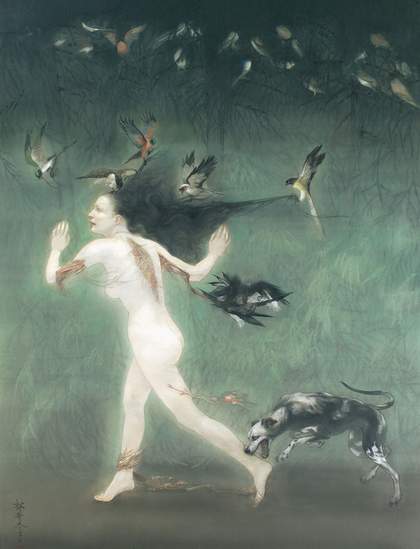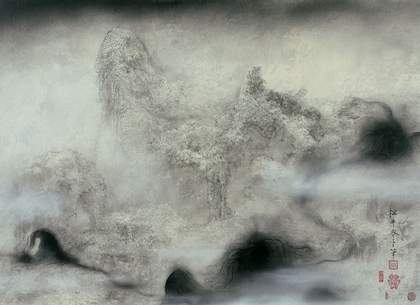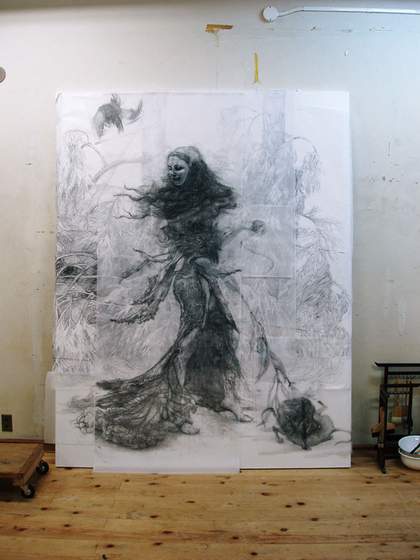Fuyuko Matsui’s studio is located in Komagome, a ten minute train ride from Tokyo University of the Arts. The area is typical Tokyo shitamachi (downtown) and retains a strong sense of community. The street is lined with stores selling Japanese sweets and everyday items, cafés, bars and restaurants, all filled with the warmth and unpretentiousness you would expect of people who have been operating these businesses for decades.
The studio is on the second floor of an old four-storey building, the ground floor of which is actually a church, although it looks more like an office. On Matsui’s front door is the word tesis (Spanish for thesis), chosen because she happened to be writing a doctoral thesis when she moved here. Inside, there are two rooms – one is her workspace and the other is, as she calls it, “a place for contemplation”, furnished with a sofa and cabinet and the walls covered in images. The workspace contains the many different materials used in the traditional Japanese painting technique known as nihonga – dishes of multicoloured powdered mineral pigments and different sized brushes, with and without handles – all placed in neat rows. The floor, on which she places and paints works in progress, is spotless.

Fuyuko Matsui
Scattered Deformities in the End 2007
Hanging scroll – colour pigment on silk
124 x 96.5 cm
Private collection
Courtesy Gallery Naruyama, Tokyo © Fuyuko Matsui
Between the two rooms is a bookshelf lined with books on traditional Chinese and Japanese painting. When this attractive 34-year-old artist solemnly mentions the names of Chinese masters such as Kakki and Baen (Ma Yuan) and the Japanese Hasegawa Touhaku, saying “I wonder why they are so talented… I wonder how much longer I’ll have to train to reach their standard”, I sense that it is not Matsui who is out of step with the times. In fact, it is me, who sees this as an anachronism, that is out of step with the essence of art.
Other publications range from the collected works of Bernini to books on Joel-Peter Witkin. They include Kaiga no shinseimei (The True Life of Painting) by artist Hayami Gyoshu, a leading force in modern nihonga in whom Matsui has a particular interest. As she says: “Gyoshu’s paintings and books taught me how to paint with stoicism and integrity; to observe the subject with more commitment, with more faith.”
The walls of her place of contemplation are covered with prints of pictures such as Portrait of Giovanni Arnolfini and His Wife 143) by Jan van Eyck, with its elaborately executed, powerful and transparent colours of the fifteenth-century Netherlands School, and the sensual women of Lucas Cranach. “The religious passion in these paintings is close to madness,” says Matsui. There are also photographs of anatomy models from the Bologna Museum of Comparative Anatomy, and stills of organs captured from a video of an autopsy that she recently obtained. She sighs as she describes the beauty of the pancreas, adding that she is currently working on an anatomical drawing of angels that involves a lot of research.

Fuyuko Matsui
Continuous Failures in the Collision of Fragments 2007
Colour pigment on silk
64.5 x 90 cm
Courtesy Éditions-Treville, Tokyo. Collection of Mr Arisawa Keita © Fuyuko Matsui
Matsui’s pictures incorporate people, flowers, animals and landscapes, but these are combined into fantastical depictions of death and violence and rape inspired by ghost paintings and rokudou-e. Ghost paintings are just that – pictures portraying ghosts that began to be produced after the fifteenth century. Many feature women unable to attain Buddhahood because they bear a grudge of some kind. Instead, they float in this world, and are typically shown with long hair, dressed in a white kimono and without feet. Rokudou-e, a name deriving from the Japanese Buddhist term rikudou/rokudo, show the six paths or realms of existence during the process of reincarnation – the Deva Realm, Human Realm, Asura Realm, Animal Realm, Hungry Ghost Realm and Hell Realm. In Buddhism, reincarnation is viewed not as a spatial phenomenon, nor as a world that one passes into after death, but as a spiritual state. Partly with the aim of proselytising the masses, large numbers of rokudou-e were produced from around the twelfth century. Matsui has been particularly influenced by those depicting the Hell Realm. Her highly narrative works are underpinned by themes such as narcissism, insanity and miscommunication.
And they only ever feature women: “Men are not familiar enough to me, and I can’t depict them with any sense of reality.” Behind this comment lie the long-term psychological effects of discrimination in male-dominated Japanese society. There is always an element of selfprojection in her work. For example, in 2004’s Jousou no jizoku (Keeping up the Pureness), a young woman lies in a field, flower blossoms from different seasons whirling about her. Her stomach has been slashed, her digestive
organs and her uterus containing a foetus protrude from the wound. Matsui explains the intention behind the image in which the woman is dead, her eyes slightly open and with an almost triumphant smile on her face: “According to anatomical reports, women are inferior to men when it comes to the development of organs other than the uterus. If that’s the case, I decided that I wanted to depict a woman flaunting herself in the form of an objectively viewed, anatomical body.” The woman has slit open her stomach to flaunt her uterus. The flowers that swirl around her are also displaying their female parts, as though attuned to this act. Her face conveys pride and satisfaction because she has carried it out herself. The work also addresses men with a possible desire to commit rape. The pain that she has passively accepted to date as a woman – the pain of being a victim, as well as the pain associated with the fear of retaliation either against the perpetrator or, at times, against herself – is now the driving force behind her power and strength.
The painting was inspired by, and refers to, one of the rokudou-e series, Fujoukan, a detached depiction of the process in which the body of a beautiful woman begins to decompose, is covered in maggots and finally is transformed into a skeleton. It incorporates a Buddhist message about purification and adopts a strategy that could be described as the theory of the gaze, in which the abjection actively achieved by the woman through her injured and offended body has the effect of deflecting the gaze back to the observer. Matsui, who is influenced by Japanese feminist critic Chizuko Ueno and the Bulgarian-French philosopher Julia Kristeva, refers to her own experiences in this process of abjection (Kristeva’s term), using aggression to transform conventional beauty and depict a revolting, uncanny, abject body. The resulting image resists or mounts a counter-offensive to the lecherous gaze of men that women are subjected to so often.
In 2007’s Inkoku sareta shishi no saidan (Carved Limbs on an Altar), a woman looks behind her, her body twisted and her organs exposed, as though acid has been poured on to her. This dissection of her own body, almost as though she is wearing someone else’s flesh, is perhaps a metaphor for a detachment and recoupling process in which a person splits so that she ends up with two personalities.
The crazed shower of blossoms is another important theme in Matsui’s work, and they blend with the landscape to create a self-portrait of the woman. The artist is greatly inspired by the manjushage, or red spider lily, depicted by nihonga painter Toshitaka Ohno. Matsui’s flowers, however, do not represent the sublime eroticism of Ohno’s, which fall into the space surrounding the subject. Her flowers are diseased and have the power to distort the landscape.
Matsui initially began studying oil painting, but changed to nihonga after becoming fascinated with the work of Hasegawa Touhaku. At the end of the nineteenth century, during the Meiji period, the materials used in oil painting as well as techniques such as perspective and shading were imported into Japan. Traditional Japanese painting was renamed nihonga as a form of rivalry to its Western counterpart (youga), but this had the effect of it becoming distanced from and losing relevance to the
reality of the times. Matsui has adopted shading that references the meticulous drawings of artists such as Leonardo da Vinci.
The first step in the nihonga process is to do a sketch. The image is transferred to tracing paper, and then, via nenshi (carbon paper), on to either linen paper stretched on a wooden panel, or silk stretched on to a wooden frame. Sumi ink is used to outline what has been transferred, a technique called honegaki. The entire surface is covered with kofun, or chalk, after which the background colour is applied. Once this has dried, the other colours are added.

Fuyuko Matsui
Engraved Altar of Limbs (draft version) 2006
Pencil on tracing paper
Dimensions unknown (destroyed)
Courtesy Gallery Naruyama, Tokyo © Fuyuko Matsui
During the process, the emotions, pain and fear that were directed into the initial lines that Matsui draws are increasingly restrained and repressed, eventually disappearing in the overall serenity of the final image. The sense of distance created by the traditional and academic technique of nihonga, and the sense of quietness and neutrality that appears as a result of this stylisation, are effective ways of grounding Matsui’s rage and anger. If her works were to be compared with those of female artists such as Kiki Smith and Eva Hesse, who have both portrayed disease in their art, and Shirin Neshat, who has depicted madness, the distinctive feature of Matsui’s practice is that she uses line to convey the gaze, and shading to convey the body. Her work is highly sensitive, violent and self-contradictory. However, when conveyed through a clear-cut classical format, her personal trauma is sublimated into something universal. Her paintings can certainly be described as feminist, but – like Goya and the Chapman brothers – they also deal with death.
